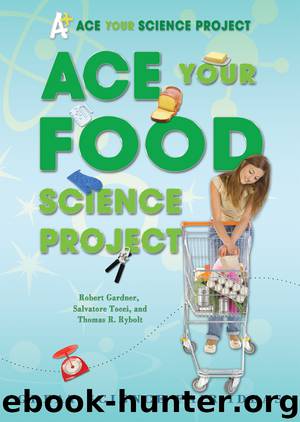Ace Your Food Science Project by Robert Gardner

Author:Robert Gardner [, ]
Language: eng
Format: epub
ISBN: 978-1-4645-0503-4
Publisher: Enslow Publishers, Inc.
Published: 2010-03-14T16:00:00+00:00
Yeasts are one-celled fungi. Like all fungi, they have no chlorophyll and, therefore, cannot manufacture their own food. Instead, they must absorb and digest organic matter. One commercially important food source for yeast is sugar. Yeasts obtain energy by converting sugar to alcohol and carbon dioxide. The chemical equation below represents this process. It shows that a sugar molecule consisting of 6 carbon atoms combined with 12 hydrogen atoms and 6 oxygen atoms, in the presence of yeast, is converted to 2 molecules of ethyl alcohol (C2H60) and 2 molecules of carbon dioxide (CO2).
C6H12O6+ yeast → 2C2H60 + 2CO2
Alcohol is the product sought by brewers, and carbon dioxide is the product that bakers use to make bread and other baked goods rise.
Glucose (C6H12O6) is often obtained from sucrose (C12H22O11), the white solid we use to sweeten our tea and cereal. Sucrose can be converted to glucose by enzymes in the cells of yeast (and by enzymes in our stomachs).
The carbon dioxide produced when yeast acts on sugar can be detected by the bubbles formed as carbon dioxide gas is released in the reaction. You can use the carbon dioxide bubbles to compare the effect of yeast on different foods.
To do this, first use masking tape and a marking pen to place the following labels next to the cups in one or more muffin tins: control, granulated sugar, syrup, powdered sugar, brown sugar, diet sweetener, flour, cornstarch, raw hamburger, salt, cooking oil, and milk. Be sure to wash your hands with soap and warm water after touching raw meat. Next, prepare a mixture of yeast and water by adding a tablespoon of dry yeast to a measuring cup that contains 250 ml (1 cup) of warm (35°C, or 95°F) water. Stir the mixture until it is uniform. Then add 1 tablespoon of this mixture to each of the 12 labeled muffin tin cups.
To the cup labeled control, add nothing more. It will serve as the control in this experiment. To the yeast-water mixture in the other 11 cups, add, as labeled, 1/4 teaspoon of one of the following: granulated sugar (sucrose), maple syrup, powdered sugar (sucrose), brown sugar, diet sweetener, flour, cornstarch, raw hamburger, salt, cooking oil, and milk. Stir the contents of each cup with a toothpick. In which ones do you see bubbles right away? Record your observations.
Under adult supervision, put the tin or tins in a warm (50°C, or 120°F) oven for about 10–15 minutes. Then check to see which samples show evidence of carbon dioxide bubbles. Place the tin(s) back in the warm oven and check for bubbles again after another 10–15 minutes. Record your observations each time. Does time have any effect on the production of carbon dioxide from the warm yeast-water-food mixtures? Which food or foods produced the most carbon dioxide when mixed with yeast and water?
What effect does the concentration of sugar have on the production of carbon dioxide? To find out, place a tablespoon of the yeast-water mixture in each of 5 muffin tin cups.
Download
This site does not store any files on its server. We only index and link to content provided by other sites. Please contact the content providers to delete copyright contents if any and email us, we'll remove relevant links or contents immediately.
Science Experiments You Can Eat by Vicki Cobb(1855)
Everyday Dorie by Dorie Greenspan(1746)
Teens Cook by Megan Carle(1539)
The Unofficial Harry Potter Cookbook Presents - 10 Summertime Treats by Bucholz Dinah(1313)
Greek Revival from the Garden by Moore-Pastides Patricia;(1237)
Annabel's Kitchen by Annabel Karmel(1237)
Bake It in a Cup! by Julia Myall(1184)
Everyday Kitchen For Kids by Jennifer Low(1181)
The Unofficial Harry Potter Cookbook Presents: A Magical Christmas Menu by Dinah Bucholz(1169)
Cooking the Italian Way by Alphonse Bisignano(1167)
The Everything Kids' Cookbook by Sandra K. Nissenberg(1160)
The Toddler Cookbook Ages 2-5 by Annabel Karmel(1152)
Cutting Myself in Half by Mary Branson(1143)
The Budding Chef by Kate Kuhn(1131)
Cooking the Israeli Way by Josephine Bacon(1125)
Mary Poppins in the Kitchen by P. L. Travers(1115)
Cooking the Spanish Way by Rebecca Christian(1115)
Tony and the Pizza Champions by Tony Gemignani(1107)
Let's Eat by Kimberley Veness(1080)
